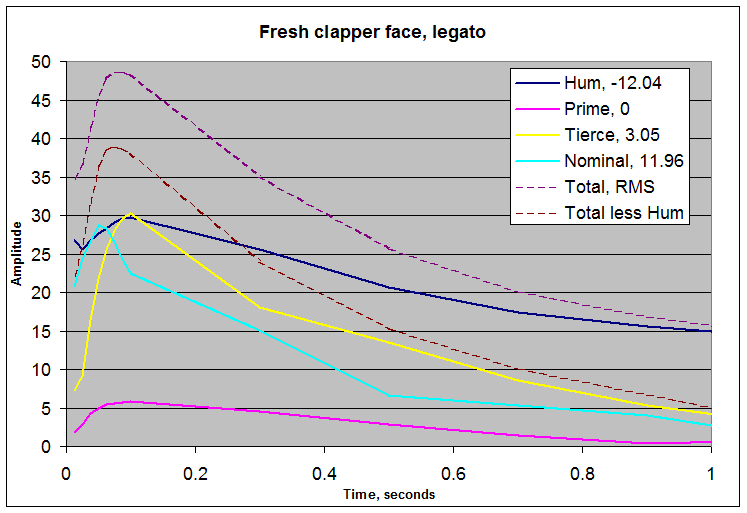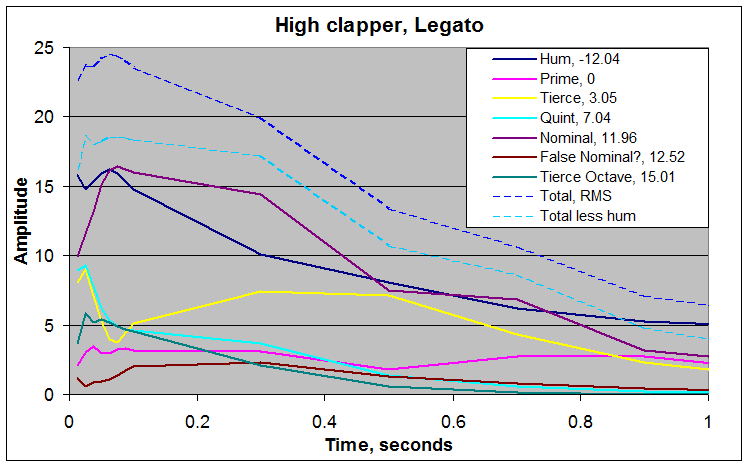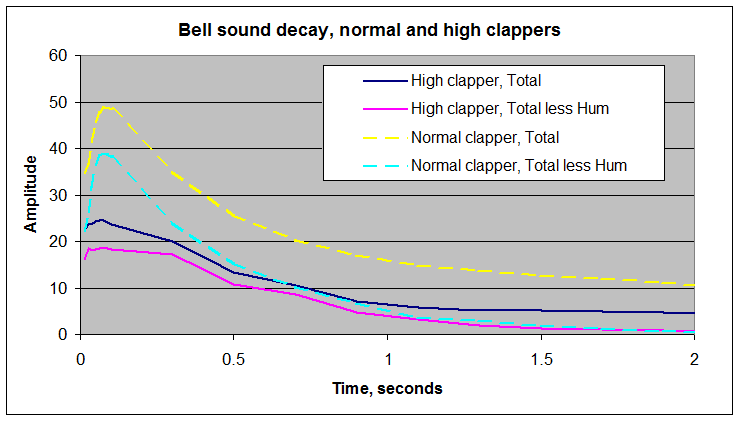|
Introduction
We have all heard of the
"sweet spot" - a location on the sound bow of the bell which the bell
tuner has identified as the best place to strike the bell. And,
fortunately for those who follow, marked it on the bell. But
what happens if we don't hit the sweet spot? Is the difference in
sound quality really subtle, something perhaps only bell tuners and a few other gifted
individuals might detect? Or is it totally in-your-face, something
only the cloth-eared could miss? Or somewhere in-between?
How can we find out?
Quite easily, as it turns
out, all you need is friends in high places.
 One such high place is
the bell tower at
Culver
Academies, where our friend is
John Gouwens,
organist and carillonist. But why Culver, you ask, why not any
carillon? Because Culver has been fitted with clappers that can be
rotated on their shaft. This enables a fresh face to be presented
to the bell whenever that's needed to deal with wear. That same
feature also
enables the clapper to be "wound up" the shaft so that it hits the bell
higher than intended. And so that's what we asked John to do.
Sneaky, eh? One such high place is
the bell tower at
Culver
Academies, where our friend is
John Gouwens,
organist and carillonist. But why Culver, you ask, why not any
carillon? Because Culver has been fitted with clappers that can be
rotated on their shaft. This enables a fresh face to be presented
to the bell whenever that's needed to deal with wear. That same
feature also
enables the clapper to be "wound up" the shaft so that it hits the bell
higher than intended. And so that's what we asked John to do.
Sneaky, eh?
We can see the general arrangement here in this image kindly supplied
by John. The clapper takes the form of a ball missing its top and
bottom. The clapper shaft is threaded, and a large nut and washer
above and below the ball clamp the ball in place. When the tiny
wear spot visible now on the face of the clapper becomes large enough to
make the bell sound clangy, just loosen a nut, rotate the ball a smidge,
and tighten up again. No more grinding (with the implicit risk to
the bell if you slip!) No more clapper weight loss. Easy to
adjust clapper height. Nifty, eh?
The plan
So what's the plan? First, we asked John to rotate the
clapper a bit to present a fresh face to the bell, just so we start with a clean
slate. And record a clapper strike. Then we asked him to
wind the clapper up the shaft a bit, and record a strike there.
John emails me the sounds and I do the analysis. Not quite as much
fun as being there....
The note's nominal pitch is F#4. John tells me the
clapper had been at 11 5/16 of an inch (287mm) down from the inside of
the bell head. When wound up as high as possible, that distance
reduced to 10 9/16" (268mm). So we're talking about differences in
height of 3/4" or 19mm, or less than 7% in clapper shaft length.
Is that enough to make a difference?
John also tried to wind the clapper down, to give us a
"clapper too low" sample, but found that, because of the curves of
clapper and sound bow, it didn't actually change the strike point on the
bell, simply the strike point on the clapper. It's possible that
introduction of some "scrape angle" by this means would produce an
audible effect, but that's not what we're testing here.
Enough talk!
OK, enough with the talking, let's hear something.
Three strikes on the sweet spot with a fresh clapper, and then three
strikes with the same clapper wound up by 3/4" (19mm). It will
take a few seconds to download...
Fresh &
High clapper.mp3
OK, I'd call that a significant difference in tone, but
not one that might bring local residents running, flaming torches in
hand, threatening to burn down the building if John doesn't get his
clapper height right. Momentarily disregarding the well-founded
advice that "talking about music is like dancing about architecture",
I'd perhaps characterise the second trio as being more "steely".
I'd also suggest that the second group are comprised of two subtly
different sounds. Not so much Bong, as Bo-ong.
(If you're having trouble hearing the difference, make
sure you have the level reasonably high, and ideally use a device with
reasonable speakers. Play the recording several times.)
So, we can hear the difference. Can we explain it?
I'll make use of Bill Hibbert's WavaAnal software in decay mode, and my
subsequent number crunching to establish overall bell sound decay
curves. (See
Internal versus External Clappers for an explanation of how that
works.)
Fresh Face
Let's start with the sound of a fresh clapper face presented to the bell
at the correct height. As we would expect, we see a text-book
response:

WaveAnal detected only 4
significant partials, whose names and deviations from the Prime are
given in the legend at top right of graph. The deviations are in
the format "semitones.cents", so we can see the Hum is 12 semitones (an
octave) and 4 cents flat of the Prime, while the Nominal is 4 cents less
than a full octave above it. Wouldn't worry about any of that!
We can also see that the full
bell decay and the full bell without Hum decay (both in dotted lines)
follow the text-book decay form. All lovely.
High Clapper
Now let's look at what happens when we wind the clapper
up the shaft by 19mm (3/4").
Woah, big changes! Firstly, WaveAnal has now
identified 7 partials of significant size, three more than we had been
dealing with.

To make the relationship clearer, I've highlighted the new additions in
the table below:
| Fresh clapper |
High clapper |
| Hum, -12.04 |
Hum, -12.04 |
| Prime, 0 |
Prime, 0 |
| Tierce, 3.05 |
Tierce, 3.05 |
| |
Quint, 7.04 |
| Nominal, 11.96 |
Nominal, 11.96 |
| |
False Nominal?, 12.52 |
| |
Tierce Octave, 15.01 |
WaveAnal wasn't prepared to name the partial at 12
semitones and 52 cents, so I've given it a tentative title of "False
Nominal?". Note that it is 56 cents (a quarter-tone) sharp of the
real Nominal. Fortunately, it's level is fairly low (brown trace),
otherwise it might really play havoc. I ran an FFT analysis of the
two sounds just to confirm. There is absolutely no sign of this
partial when the bell is struck at the right spot; it does appear and
only appears in the high clapper sound. Perhaps the most
notable difference is the Tierce partial. In the ideal strike
point, this is one of the major partials; in the Too High strike point
situation, the Tierce is suppressed at first, before fighting its way
back. We saw in the
Internal versus External
Clappers article that the Tierce was a major difference there too.
Indeed, is this an explanation of my feeling that the High Clapper sound
comprised two subtly different sounds in series? Is the early
sound being dominated by the Nominal, until joined by the Tierce from
around 0.3 seconds in?
Overall tone development
So, what's the overall impact of striking the bell too
high? As well as the tonal impacts implied by the rearrangement of
partials, there's also an overall volume impact. When we take my
computed overall-sound and overall-sound-minus-Hum for both bells, and
plot them on the same scale, this becomes quite clear:

In summary, we can say the "too high" clapper strike is failing to
energise the bell's most efficient modes, but is energising some less
attractive ones.
Conclusion
Quite encouraging isn't it. We normal humans
can hear the difference between a bell struck at the right spot and
the same bell struck a little higher. (Don't give up the day job
to seek out a new career as a bell tuner just yet; I suspect there's a
little bit more to it than that!)
Further, we can delve into those sounds to find out why
they are different, and, when we do, we find that the software can also
discern those differences. That means we can probably use it to
investigate more subtle differences than this one. I look forward
to that.
Acknowledgements
My thanks to:
Further discussion
To discuss issues raised (or that should have been raised),
go to the GCNA forum on
technical discussions.
|